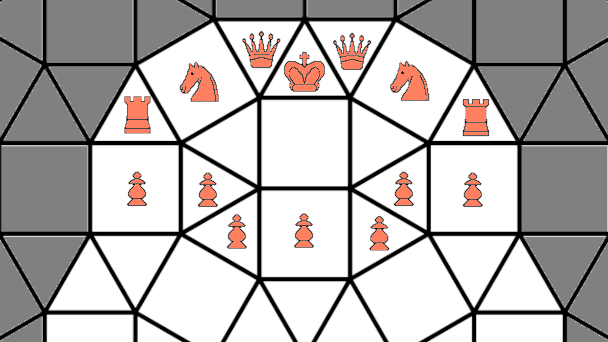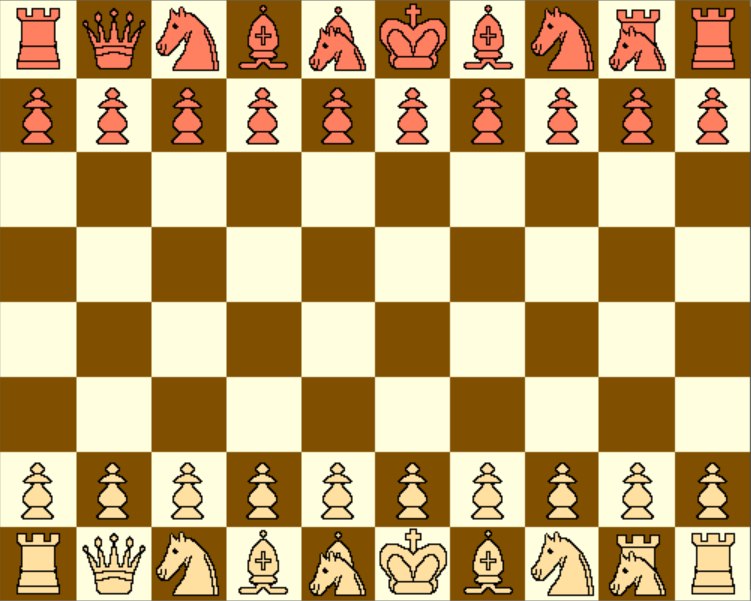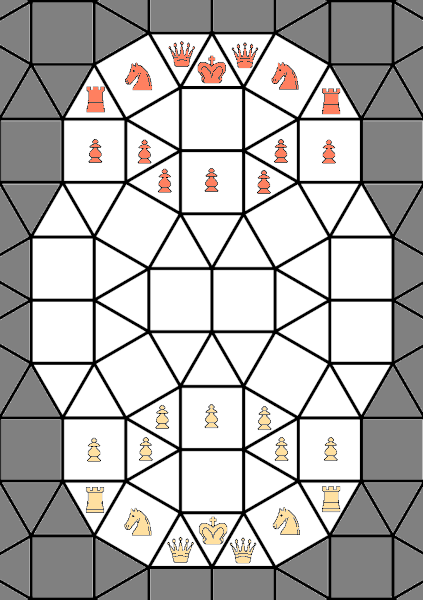Chess Variants

Over the years, I have dabbled a little in Chess variants: How to change the rules of Chess and still have a fun game. Chess variants is one of those things where it’s easy to “invent” new rules for Chess but it is very hard to master said invention or to get people interested in playing the Chess variant.
For a long time, Chess variants were an eccentric hobby with very few people interested in this. This has recently changed and we now have an officially endorsed Chess variant.
Since I think it’s not responsible to invent a Chess variant without doing extensive testing to see if the variant is one which is viable, I have, over the years only officially created two Chess variants:
- Schoolbook Chess
- Turtle Shell Chess
Schoolbook Chess

Back in the mid-first-2000s-decade, there was a lot of discussion about which setup was the best setup for Capablanca chess. Capablanca chess is a variant of chess where the board is made 2 files (columns) wider but remains 8 ranks (rows) high, and two new pieces are added:
- A piece which moves like a bishop or knight, which I call, in Schoolbook, an archbishop.
- A piece which moves like a rook or knight, which I call, in Schoolbook, a marshal.
Schoolbook initially had complicated castling rules, but in its current form, castling is always three squares towards the corresponding rook.
Initial testing did not find significant advantage for White. Then, later on, back in 2009, the strongest engine which could play Schoolbook chess was H.G. Muller’s excellent Joker80 engine, which seemed to show White had a strong advantage after 1. c3. Because of this, I put Schoolbook chess on the shelf and tried out another opening setup.
More recently, the even stronger Fairy Stockfish engine has come out, which can handily defeat Joker80, and it shows that Schoolbook chess, in fact, is one of the most balanced Capablanca chess opening setups, with a relatively low advantage for White. This in mind, I have gone back to considering Schoolbook to be the best Capablanca opening setup I have come up with.
The best way to play Schoolbook chess (Note: this version uses the older castling rules) is probably with ChessV (alternate download link), which is a free download for Windows and other .net compatible systems (it probably works in Linux, but I haven’t tested it).
Between 2006 and 2008, I worked on an implementation of Schoolbook chess for Zillions of Games. The zip file with that implementation not only has a Zillions version of the game (albeit with the older complicated castling rules), but also contains mating problems from actual (albeit computer-vs-computer) Schoolbook games and discussion about openings.
In 2022, I updated my implementation of Schoolbook for Zillions of Games to have a version with 3-square-castling and some notes based on a Fairy Stockfish with NNUE study of Schoolbook’s opening position. To download this version:
- Schoolbook.zip
- Schoolbook-2022-US.zip (this version uses some images which might be copyrighted outside of the US.)
The strongest program that can play Schoolbook is Fairy Stockfish; to play Schoolbook in that engine, tell it to play Capablanca then give it the following setup:
rqnbakbncr/pppppppppp/
This can be done with the setboard command, or via an appropriate Fairy Chess GUI, such as Xboard with H.G. Muller’s updates (included in the mainline release).
After a few hours of running, Fairy Stockfish 14, along with a Capablanca NNUE file, in a 36+ ply analysis, says White has five good first moves:
- 1. e4 where Black’s best reply looks to be Ng6
- 1. Mh3 where Black’s best reply looks to be Ni6
- 1. Ng3 where Black’s best reply looks to be d5
- 1. d4 where Black’s best reply looks to be f5
- 1. c3 where Black’s best reply looks to be e5
Turtle Shell Chess

Long before I was interested in making a Capablanca chess variant, I found, in a mathematics book at my university, an interesting tiling of squares and triangles which the Wikipedia now calls the 33344-33434 tiling.
For years, I thought about how to make a playable Chess variant with this tiling. Finally, in 2021 I wrote a program which can draw this tiling, and in 2022 I have fully implemented a Chess variant on this tiling.
Because this variant uses a non-standard tiling, the only implementation of the variant is for the classic universal abstract game engine Zillions. I have made a Zillions version of the game; the zip file also has a PDF file with full rules for the game.
The full rules are also on the Chess Variants server.Some thoughts:
- The game in some ways resembles Chinese Chess (Xiangqi) more than chess. The king is weaker, the pieces are more like Xiangqi pieces than chess pieces (read: No bishop) and the pawns can only move straight ahead like in Xiangqi and Shogi.
- The game has been designed to minimize draws: Pawns can quickly promote to rooks, the king has a limited move making it easier to mate, and in case of not having enough mating material, the game can be won by simply racing the king to the other end of the board.
- The game seems to be strategically more simple than western Chess, since pawn chains don’t exist, but it obviously hasn’t been played enough for anyone to know how deep the game is.
The variant is public domain, so anyone is free to make an online server playing the game. That said, if I were to go that route, I would like to see something which supports correspondence games, can make pretty images of the board position, and enforces the rules of the variant, ideally using free and open source software.
After releasing Turtle Shell Chess, I found out about Onyx, a Hex variant with interesting capture rules that uses a similar (but not the same) board. Onyx can be played online.
FIDE: Variants now supported
For the longest time, some in the Chess variant community would call standard chess “FIDE Chess” because FIDE was notable for only supporting the standard game of Chess, with hardly a mention of variants.Times have changed. FIDE now supports some 959 different variants of Chess: They have full support for Chess960, which is Chess with, instead of one starting array of pieces, has some 960 possible starting arrays.
FIDE has had an official world championship for Chess960, featuring the world’s strongest players of standard Chess, and Grandmaster Wesley So defeated standard Chess reigning world champion Magnus Carlsen to become the official Chess960 world champion.
Chess960 has fully caught on and is mainstream: All of the major Chess servers on the Internet allow one to play Chess960. Over at Lichess, people have played well over 6 million games of Chess960, to the point that each possible opening setup has been played thousands of times. Chess variants are no longer an eccentric hobby with a small following; mainstream players, including the best of the best, are playing Chess960.
It’s now possible to study thousands of real world Chess variant games over at Lichess; for example, with nearly 8,000 real world games for each setup, it’s now possible to study, for example, the opening of the RNBBQKNR opening setup of Chess960.
Indeed, there has been real world study of the openings in Chess960, mainly trying to find out which ones are the most balanced.
For the longest time, I wanted a Chess variant to become mainstream, to become a variant played by standard Chess players. With Chess960, this has finally happened. It may not be the perfect Chess variant—I am no fan of its castling rule, for example—but no variant is perfect and this variant keeps the general feel of Chess without needing to memorize long opening lines.
What variants I will play
For me to consider playing a given chess variant, I go by the following rules of thumb:- Maximum number of squares on board: 110
- Maximum number of different pieces: 10
- Maximum number of pieces per side: 24
My favorite chess variants
I can not be objective about my own chess variant inventions, but here are my favorite chess variants invented by others. For a variant to get on this list, I must have played at least one game against another human.- Embassy Chess, which appears to pretty strongly favor White, but is probably my favorite 10x8 chess variant.
- Grand Chess, which, being a larger more open board, appears to give White less of an advantage than in 10x8 Capablanca Chess variants.
The reality of chess variants
It’s pretty common, when people make a chess variant for the first time, to do the following:- Propose that their chess variant become the next version of chess
- Propose a chess variant with a really large board and/or a large number of different pieces
- Have grandiose fantasies of thousands of people playing their variant or making lots of money with the variant
- The only chess variant we can even consider becoming the next version of chess is Chess960. Even here, as of 2022 we have not had a serious Chess960 tournament since 2019, while dozens of serious chess tournaments have happened in those same three years.
- Grandmasters, even grandmasters open to playing variants, tend to not like playing on anything besides an 8x8 board.
- “Menagerie” variants with well over a dozen different pieces are very common. The only variant I have seen with over 10 different piece types catch on is Chu Shogi, but even here, the number of Chi Shogi players is eclipsed by the number of standard Shogi players.
- Most chess variants are only played a handful of times, then are quickly forgotten. For example, I went to a lot of effort to make a chess variant in the mid-first-2000s-decade. In total, maybe 30 human-vs-human games were ever played. Grand Chess, which was really popular in the 1990s to first-2000s-decade, has under 20,000 total human-vs-human games ever played; Lichess, on the other hand, has millions of chess games played every day.
See also
- ChessV (Alternate download link)
- Play Strategy is based on the Lichess code, but includes all games from lidraughts.org, lishogi.org, and adds a number of other abstract games too.
- My profile on Zillions’ website
- Eric Silverman’s blog on games
- Fairy Stockfish, hands down the strongest Chess variant engine out there.
- Variant Chess magazine archive (all issues are now free PDF downloads)
- Abstract Games magazine is now free to download but donations are accepted.
- Nick Bentley’s list of abstract games
- Arimaa, one of the best new (i.e. this century) abstract game inventions.
- Tak, another excellent new abstract game invention. Similar to Hex, but with some interesting twists.
